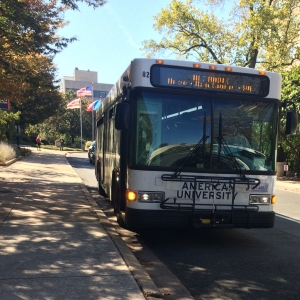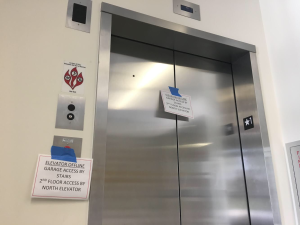By Hannah Engle
Fiona Murphy, 18, was almost late for class. She had just finished going to the monuments with her friends and hoped to make it back to campus in time for her next class.
The Nashville native wheeled her wheelchair up to the American University shuttle bus. She prepared to get her wheelchair on the bus when the bus driver told her there was no more room.
Murphy had experienced this type of problem at AU before.
“The university obviously doesn’t train bus drivers properly on how to deal with wheelchairs,” Murphy said. “The bus driver told me there was no room when I knew I could fit on that bus.”

As the University struggles with issues of diversity and inclusion, students with physical disabilities interviewed on campus this fall say they are having accessibility problems on campus and feel left out of the system.
Students with physical disabilities make up 1 percent of college students according to the Department of Education.
Murphy has a genetic disease that will leave her in a wheelchair for the rest of her life. Halfway through her first semester at AU, she has had both positive and negative experiences with campus accessibility.
The university office primarily responsible for accessibility on campus is the American University Academic Support and Access Center.
Calls and emails directed at ASAC requesting an interview were ignored. Upon contacting American University’s Center for Diversity and Inclusion, a staff member directed this reporter back to ASAC. The University Communications Office was unable to put this reporter in touch with ASAC.
ASAC has developed many services to improve the experience of physically disabled students on campus.
Murphy said she finds many of ASAC’s services helpful including their text alert system for elevator construction and the grievance report system. But, she still feels that parts of the system need improvement.
The text alert system is one such service, according to Murphy. The system sends texts to registered students with physical disabilities that alert them when elevators are undergoing construction.
Murphy says that the system works and can identify when elevators are under construction, but notes that improvements could be made.
An issue Murphy experienced with campus elevators early in the semester led Murphy to suggest that ASAC add text alerts for elevators that are out of service, not just elevators undergoing construction.
On the way to the second class of her freshman year, Murphy came across an out of service elevator on East Campus. While there was another in service elevator in the building, as a freshman, Murphy had no idea where it was located.
“I barely knew where my class was, much less where the other elevator was located,” Murphy said.
The incident made Murphy late to her first day of that class. While Murphy said the professor was understanding, Murphy does not want missing class due to elevator outages to continue.
Murphy says that creating an elevator outage text alert that directs students to nearby elevators would make it much easier for her and other first year students to navigate the new buildings and make it to class on time.

Murphy’s problems with accessibility on campus come as the university tries to deal with issues of racial diversity and inclusion on campus.
In spring of this year, AU experienced a racial incident where bananas were hung from nooses around campus right after Taylor Dumpson, the first black president of student government, was elected.
The incident triggered campus wide discussions on how to make the university more inclusive, including a town hall and numerous campus sponsored events related to diversity.
But in the fall, another racial incident happened. This time, flyers with confederate flags and real cotton attached to the flyers were posted around campus.
In light of these two racially motivated crimes, students feel dismayed with race relations on campus.
Emily Dragan, 18, is only in her first year at AU and is already familiar with the racial climate on campus. She has heard about previous incidents from older friends and experienced the most recent racial incident firsthand.
“These are pretty serious events that are happening on campus,” Dragan said. “It’s really concerning to see these racially-motivated crimes on AU’s campus.”
However, in light of these incidents, students like Murphy with physical disabilities are often left behind.
Murphy is awaiting a response from ASAC after contacting them about her incident with the AU shuttle bus. She hopes that ASAC will resolve the issue both for her own sake and the AU community as a whole.
“If the bus drivers don’t receive proper training, it is a danger not just to me, but the other students on the bus,” Murphy said.

You must be logged in to post a comment.